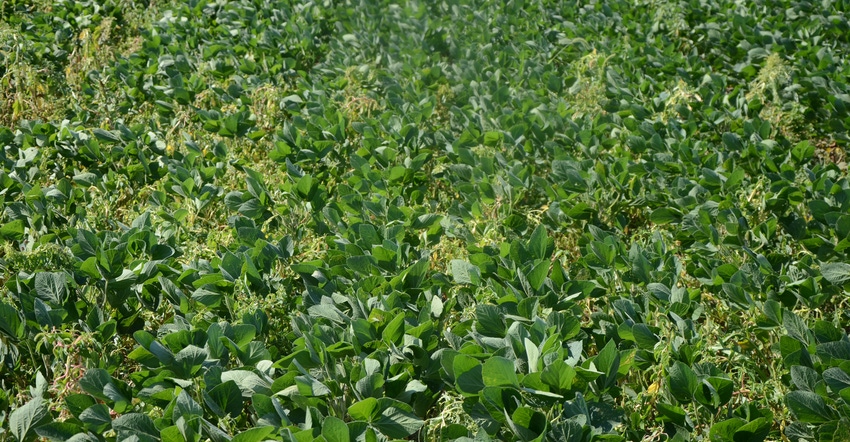
In Nebraska, waterhemp populations have developed resistance to six different modes of action — the latest being resistance to PPO inhibitors.
"If you have a waterhemp population that's resistant to glyphosate and PPO herbicides and you want to manage waterhemp postemergence in soybean, those are two big tools used in soybean production that would no longer be available," says Chris Proctor, University of Nebraska weed management Extension educator.
"Waterhemp also has a long emergence window, and it grows fast. When it emerges from mid-May until mid-August, that's a hard weed to manage. When it goes from emergence to 12 inches tall in two weeks under ideal conditions, the window of opportunity for effective control is pretty narrow."
That's why managing waterhemp and other pigweeds in soybeans takes as many tools in the toolbox as possible, Proctor says. This includes agronomic practices such as row spacing and planting date, as well as chemical approaches such as using multiple modes of action.
"Leverage as many of these things as you can, knowing there is not one thing alone that's going to solve the problem, but when you put them all together, you give yourself a fighting chance," Proctor says.
Effective tools for control
However, one of the more effective tools right now may be the traited soybean varieties with multiple resistances coming down the pipeline, Proctor adds.
This includes LibertyLink GT27, which will be available later this year, with resistance to glufosinate, glyphosate and a new HPPD-inhibitor, Alite 27 (which won't be marketed until 2021) — as well as Enlist E3 soybeans, which have resistance to 2,4-D choline, glyphosate and glufosinate.
However, Proctor advises against relying on these technologies as the sole method of control — as 2,4-D and dicamba already are used in corn production in many parts of Nebraska, and 2,4-D and dicamba-resistant Palmer amaranth populations have been identified in Kansas.
"Some of these tools that are effective for us, you can lose them as quickly as you get them," Proctor says. "We really need to be careful how we use these tools."
That means using overlapping residuals and using multiple effective modes of action — and mixing them, not simply rotating them year after year.
"It's hard to make up ground if you get behind on these weeds," Proctor says. "Ideally, you want to be in a situation where you never see them. If you have a good burndown with residual, then before the residual breaks, come back with a second application with some residual activity and get the soybeans to canopy as quickly as you can.
"Research shows that mixing modes of action is far more effective than rotating. Anything you can do to apply multiple modes of action at once is really critical."
And best practices can't be overlooked when it comes to applications and spray coverage, and this includes paying attention to the labeled application rate as well as the carrier rate, which determines droplet size.
"You can make up for a lot of shortcomings in poor nozzle selection by applying products with a higher carrier rate — if you're down to an 8-gallons-per-acre application rate with Liberty, for example, it starts to show shortcoming of application," Proctor says. "If you're up higher, more than 15 gallons per acre, you can offset a lot of that. For many applicators, there's a trade-off there. You want to fill your spray tank as few times as possible to get across the field, but if you cut it too much, you start to pay for it in application efficacy."
Other tools in the toolbox
While arguably the most important component for many growers, chemical control isn't the only layer of an effective approach at managing waterhemp in soybeans.
Row spacing is another factor. When switching from 30-inch to 15-inch to 7.5-inch row spacing, the critical period for weed control moves from V1 to V2 to V3, respectively, according to research by Stevan Knezevic, Nebraska Extension weed management specialist. Planting date also plays a role. Planting by late April increases the chance of canopy closure by early July.
While a relatively newer approach, cover crops also have a role to play in weed suppression.
"Anita Dille from Kansas State University, a year or two ago, researched cover crops and Palmer amaranth," Proctor says. "They showed a month's difference in emergence of Palmer amaranth between no cover and a grass cover crop. They pushed the time of 50% emergence from mid-May to mid-June.
"It didn't eliminate the Palmer. It still emerged, but it emerged later. This could give more time for soybean to canopy, and have more time to apply a residual herbicide. Having that month delay can make a big difference."
"My thinking is you need as many tools in your toolbox as you can get your hands on," Proctor adds. "You've really got to think broadly."
About the Author(s)
You May Also Like






